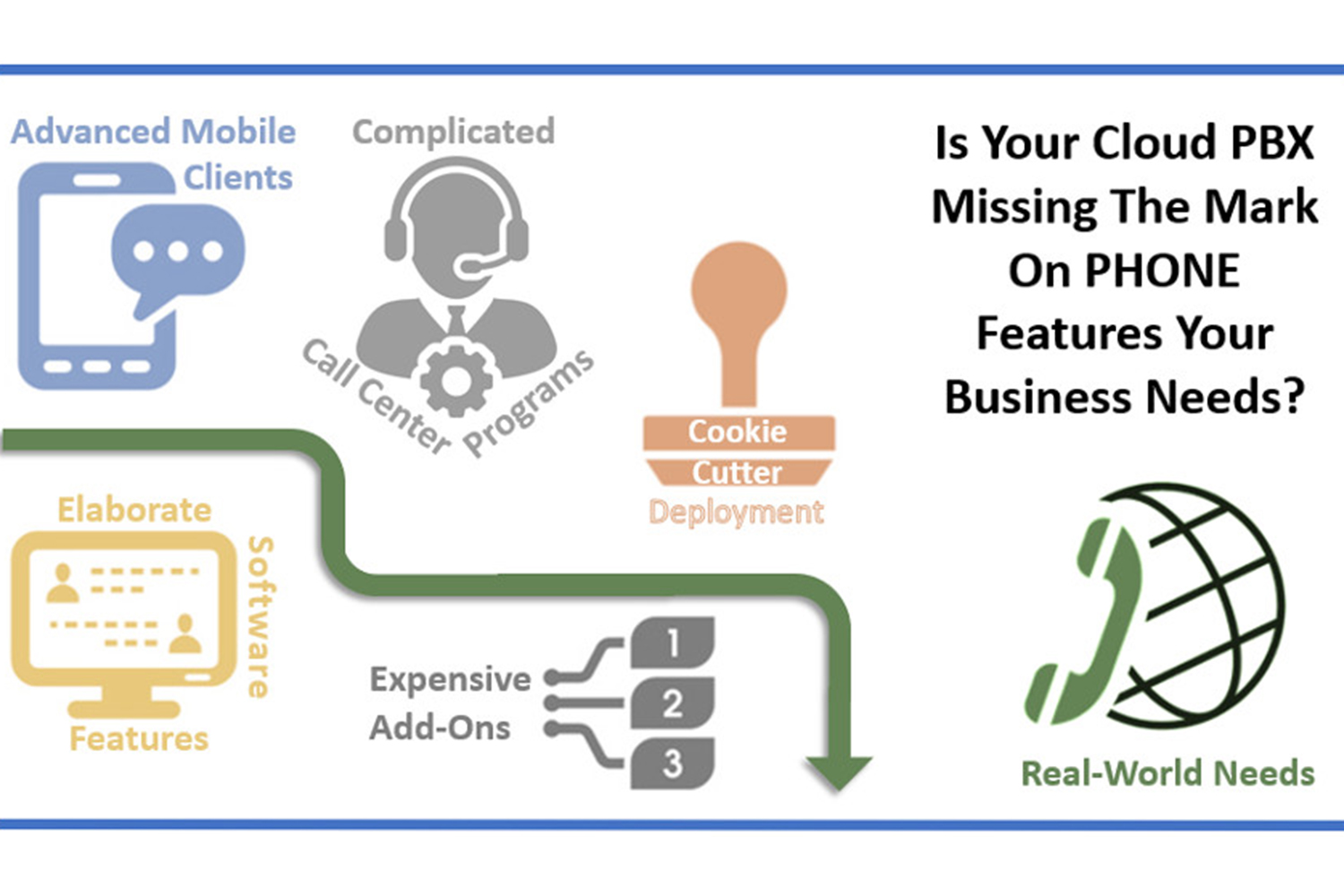Accelerating First Contact Resolution: How to Measure, Understand, and Improve your FCR

In a recent survey of contact center professionals through our partnership with the Association of Government Contact Center Professionals (AGCCP), First Contact Resolution (FCR) was chosen most often as a key problem. In this article, we will discuss why FCR is so important, how to get a better handle on your contact center’s FCR, and specific suggestions for addressing specific challenges to FCR.
Why is FCR Important?
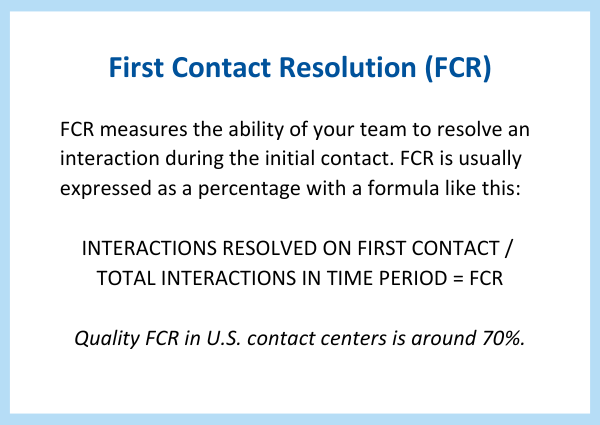
A high First Contact Center Resolution has a number of benefits to your organization. The most obvious (but often ignored) is that a high FCR means a lower total interaction volume for you contact center. Whatever the volume is for your contact center, making sure you don’t get repeat requests on the same issue can’t help but drive the total volume down. This encourages better staffing efficiency, shorter wait times, and more unique customers handled. One of the key benefits here is lower operational costs.
Lower call volumes also helps with Agent Attrition as the number one leading call of agent dissatisfaction is overwork and lack of time to adequately complete their tasks. A further advantage is the sense of satisfaction gained by agents when they have a successful interaction and help their contact out. Repeat callbacks also are a leading cause of stress for agents as they customer tends to have a higher emotional state when having to re-contact on an issue.
A high FCR also improves customer satisfaction and the customer experience. Having their issue resolved on the first contact shortens the time to resolution as well as eliminating the frustration of multiple contact attempts. This also results in a better image for your organization and encourages more engagement with your organization.
Measuring Your Contact Center’s FCR
The key to improving your First Contact Resolution is measurement. While we provided a formula for FCR in the box above, the real problem is determining if an interaction was truly handled on the first interaction. This isn’t easy and will require multiple measurement tools.
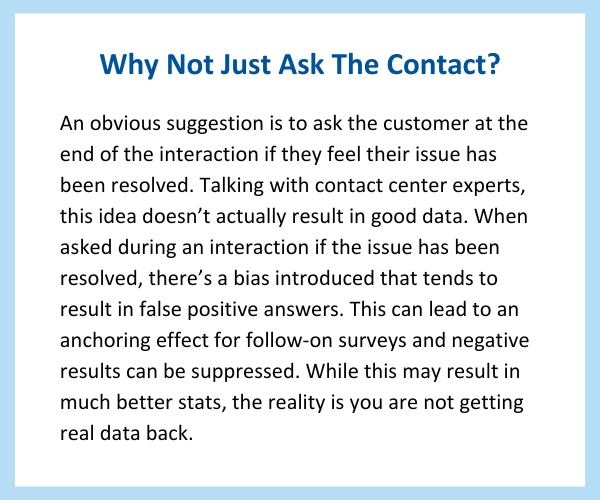
The first tool for measuring FCR is with a ticket tracking system. Providing this to customer gives a clear point of reference and can be used to track future interactions. This allows tracking each interaction on a single ticket. Having the right technology that connects your CRM or ticket system directly to your interactions is important here. You don’t want to just depend on the agent to log each interaction manually. Ideally, you want your communications platform to interact directly and create log entries for each interaction. The cutting edge is to use automated AI to summarize the call and connect it to a specific ticket. These systems can address issue with customers losing their case number or not remembering a previous interaction. Even without the latest technology, agents should be able to use your systems to identify the previous ticket. Training to avoid duplicate tickets is important.
A second tool for measuring FCR is your customer feedback systems. This could include Voice of the Customer (VOC), Net Promoter Score surveys (NPS), Customer Effort Scores (CES) or other customer feedback systems. Inserting a question into these systems about if their issue was resolved on the first interaction. These systems don’t just answer the objective question, they help you understand the customer’s subjective understanding of the experience.
A third tool is your interaction tracking analytics. Your communications platform should provide reporting on interactions and their source. This allows you to identify repeat contact interactions (same phone number, e-mail, etc.) to investigate if they are unique issues or the same problem. Recordings, call transcripts, and your ticket tracking can all help resolve this. The downside is that this can be labor intensive. The latest cutting edge tools can use AI to narrow the list of repeat interactions.
One of the ongoing measurement challenges is the human factor. Your customer may call from multiple phone numbers (cell, home, work). They might misremember previous interactions. Your agents may enter data incorrectly. All of these combine to make each source of information suspect. You can resolve this by using multiple sources.
Understanding Your Contact Center’s FCR Challenges
If your First Contact Resolution is low, there can be a host of reasons and these answers are specific to your organization. Once you can measure FCR, you need to dig in on potential problem areas for your organization. Your measurement efforts can provide you a list of contacts that required multiple interactions to resolve. It’s worth researching this list to understand your problem areas.
- Customer Feedback- Just as it provides you data for your measurement, any freeform comments can provide insight to what specific problems prevented first contact resolution. Read these carefully to identify issues.
- Agent Feedback- Engaging with your agents on the specific interactions is another way to better understand problems. Use your list to review what problem or difficulty may have prevented resolution of the issue. This can be especially helpful in identifying training and resource gaps within your contact center.
- Ticket Tracking- The information in your ticket system can help you spot the problem as well. This can be manually entered notes from your agents. It can also be automated summaries generated by an AI agent. Reviewing entries can help identify your problem areas.
- Recordings/Transcripts- Diving a bit deeper, you can review the recording or transcript of each interaction string to see why multiple interactions were needed. This can be labor-intensive, but AI can be helpful here again. The latest toolsets will review all interactions and highlight problem areas and even make recommendations. We recommend a human still review recommendations to make sure they make sense, but this can greatly improve your process.
- Workflow Analysis- Incorrect interaction routing can be a common cause of multiple interactions. This includes routing to the wrong queue where agents don’t have the right skills or resources, not having successful diversion methods to keep interactions down to a manageable level, bottlenecking the flow of interactions, or not having options to meet customer needs. Tools that track the customer journey through your communications platform can help identify these problems more quickly and reduce repeat interactions.
- Transfer/Escalation Analytics- One sign of FCR problems is a high rate of transfers to other agents or escalation to supervisors. While these actions can technically result in a First Contact Resolution, they often indicate that your workflows are not connecting the right agents with the right customers. Looking for trends in transfers and escalations can help identify workflow issues that may result in customers having to connect multiple times to your organization.
Common Solutions To FCR Problems
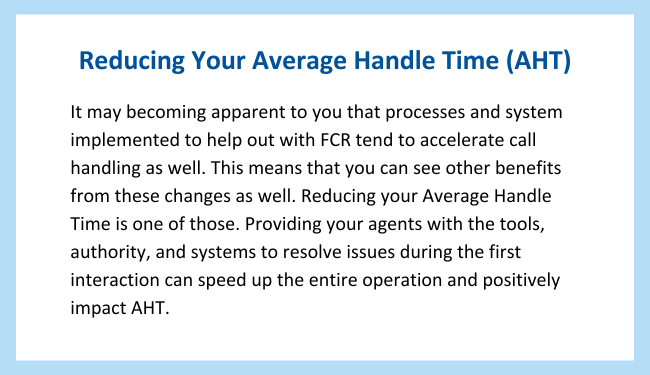
While each contact center has specific problems, and it’s important to identify these issues, there are common problem areas that crop up. Here’s a list of solutions to some of these problems.
- Training Shortcoming- One of the most common problems is a lack of training for agents. Finding time to train new agents and to upskill existing agents is always a challenge, but ensuring you have an adequate training and skills evaluation plan is a critical to ensuring a good FCR.
An additional aid can be Agent Assist technologies. These provide real-time checklists and information to the agent to ensure they are following best practices. The best of these systems can listen to the conversation in real-time and make context-sensitive suggestions. While these systems are not a substitute for a robust training program, they can be very helpful honing on the job skills as an adjunct to formal training. - Lack of Resources- Another common problem area is agents not having the right resources to resolve customer interactions. This can be as simple as not having permissions or even access to the right system, but the most common issue is a lack of knowledge. Building a robust knowledge system is the answer here. This should be a combination of existing resources as well as lessons learned from the operation of your team.
- Difficulty Finding Resources- A closely related problem is the searchability or ease of access to resources. If your knowledgebase is not easy to use or does not have robust search tools (which the agent is trained on), then this can easily lead to a resolution failure. Making sure that you don’t just have the resource, but it’s usable is critical to success.
Agent Assist solutions can help here too as they make searching for the right answers much faster and easier for your team. The context-sensitive models that listen to the conversation are especially powerful in this role presenting the data to the agent as it is needed with little to no search time needed. - Empowerment- Sometimes the problem is that an agent simply doesn’t have authority to make a decision or offer the obvious solution for a customer. This can be a major challenger to FCR. While appropriate controls have to be in place, it’s important to consider how best to empower the agent to quickly be able to make the call to help out a customer. Finding the balancing point between having oversight of potentially costly decisions and giving the agent the power to solve customer problems can be difficult, but it’s key to good FCR. A strong inter-company chat tool can be used to help empower the agent by quickly allowing the agent to request an approval without having to end the interaction with the customer. This requires careful planning and staffing of the manager or other authority providing the approval, but this solution can strike a good balance between empowered agents and necessary controls.
- Soft Skills- An area that can be missed is agent interaction skills. It’s important that agents are friendly, convincing, and confident. To achieve good FCR numbers, it’s not just important to enable your agents to give the right resolution, the customer has to believe in the solution. Otherwise, they may just call back in to “double-check,” or to “because they weren’t sure.” Training your agents can reduce these callbacks.
- Specialist Skills- Not every agent can be an expert in every customer need. Sometimes, it’s necessary to have specialist agents with additional training, experience, or toolset to handle customer needs. This situation can negatively affect FCR rates, but there are solutions. One solution is to pull these experts out of the general agent population and make them an escalation queue. This allows a hand-off of the customer to the resource best suited to resolving their issue.
This solution does require careful management of another queue. Depending on the need for these experts there may be a balancing act of allocating their time (maybe their skills are rarely needed). It’s possible to have these experts still remain in your general agent population but use skills weighting to route fewer calls to them.
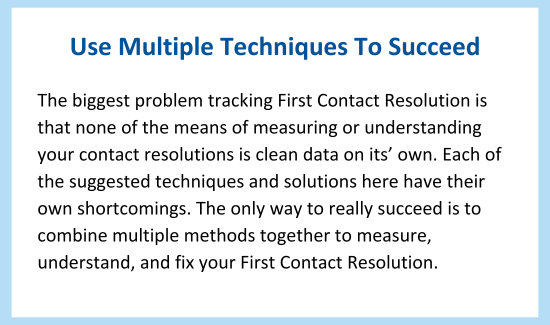
These are just a few of the problems that can affect your FCR score. It’s also possible that First Contact Resolution isn’t appropriate for your organization. If your interactions involve highly complex topics or customers routinely need to get more information and return to you later, then FCR might not be the right KPI to track. If you need more help figuring out FCR or have issues that aren’t addressed here, Vertical Communications experts are happy to help.
